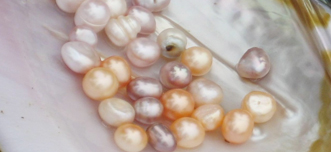|
| About Freshwater Pearls |
 |
Freshwater Pearls are cultured in mussels or oysters in rivers, lakes or ponds and tend to be more irregular in shape and more varied in color than saltwater pearls.
Nearly 96% of freshwater pearls today are produced in China. With the development of culturing techniques, Chinese freshwater pearls have played an even more important role in the jewelry industry than ever before. |
|
|
| Freshwater Pearls vs Saltwater Pearls |
| Freshwater pearls' lower price than saltwater doesn't necessarily mean low quality. In fact, some high quality freshwater pearls are very valuable. Typical sizes range from 4 mm to over 10 mm. The various freshwater pearl shapes can be used to make impressive looking jewelry pieces that sell at affordable prices. |
| Because freshwater pearls do not start with shell nuclei, and are produced in mussels (each of which can produce several pearls), they are composed 100% of "nacre," the calcium which, over time, coats the nucleus. |
|
| Grading Freshwater Pearls |
| The grading of freshwater pearls is more variable than that of saltwater pearls because freshwater pearls are more colorful and are available in various shapes. But we can still generally assess their value according to the 7 factors: |
|
| Luster and Nacre |
When cultivating freshwater pearls, there is no need to insert a shell bead. All that is needed is the insertion of a piece of mantle. After the first harvest, mussels can spontaneously grow pearls a second time. That means cultured freshwater pearls either do not have nucleus or have a very little one inside, hence, freshwater pearls are make up with very thick nacre.
Only those freshwater pearls with evenly high luster can be considered as high valued ones. |
| Only those freshwater pearls with evenly high luster can be considered as high valued ones. Judge luster see Luster and Nacre |
|
| Surface Quality |
| Blemishes such as discolorations, pits, bump, wrinkle and cavities can decrease the value of pearls. |
| Surface Quality |
|
 |
|
| Color |
| Freshwater pearls come in a wide variety of body colors: white, pink, orange, yellow, lavender, gray. When determining what color to buy, keep this in mind: The color doesn't affect the price of freshwater pearls as much as it does that of saltwater pearls. |
| Pink or silver overtone can increase a freshwater pearl's value, as does iridescence. Natural color freshwater pearls are more valued than treated freshwater pearls. |
| Colors |
|
 |
 |
 |
 |
 |
|
| Pink |
Lavender |
Red |
Chocolate |
Black |
|
| |
|
 |
 |
 |
 |
 |
|
| White |
Silver |
Cream |
Purple |
Green |
|
| |
|
 |
 |
 |
 |
 |
|
| Yellow |
Lime |
Blue |
Peacock |
Gold |
|
|
|
| Shape |
| By inserting different shapes of nuclei, freshwater pearls can assume unique shapes not found in the saltwater variety of pearl. Thin shaped freshwater pearls tend to sell for less than fatter-looking pearls. Symmetry and roundness are of higher value than baroque or off-round. |
| Shapes |
|
 |
 |
 |
 |
 |
 |
 |
|
| Round |
Coin |
Stick |
Keishi |
Baroque |
Rice |
Teardrop |
|
|
|
|
| Size |
| The size of a freshwater pearl is not as important of a price factor as is its luster and surface quality, but the rule of "the larger, the more valuable" s till applies. |
| Size |
|
 |
|
| Treated Freshwater Pearl |
| Often freshwater pearls are treated to obtain fanciful colored pearls in various shapes. Treated freshwater pearls bring the fashion industry more variety and design opportunities. The most often used treatments are bleaching, dyeing, or irradiation. Large cultured freshwater pearls combined in jewelry with small sizes of various shapes (round pearls, coin pearls, button pearls, rice pearls, stick pearls and keishi pearls) make an exciting fashion statement. |